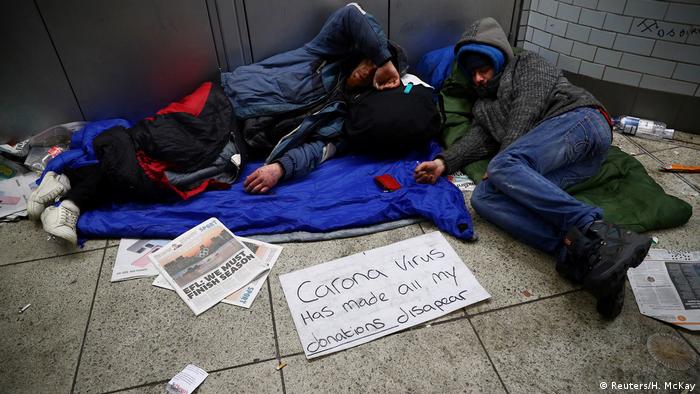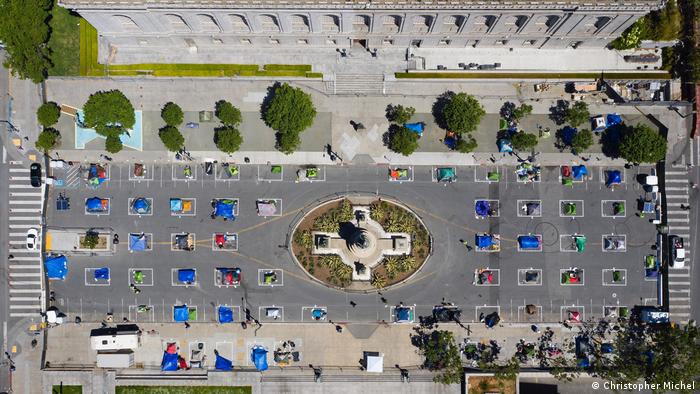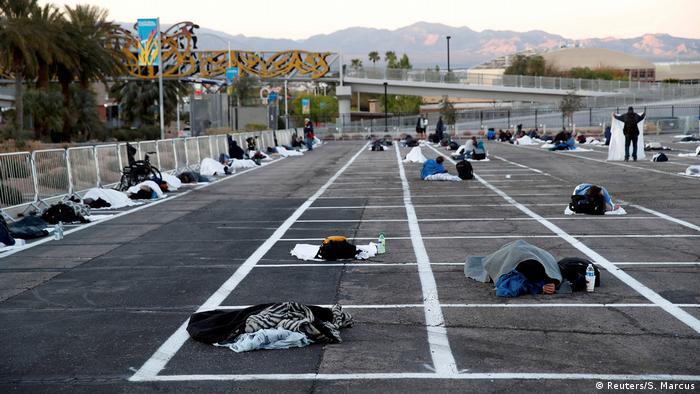Rising homelessness is a worldwide problem that has been exacerbated by the pandemic. An exhibition in Hamburg is looking at how to deal with the crisis.

Homeless people inside Westminster underground station in March 2020
According to United Nations estimates, 1.6 billion people worldwide currently live in inadequate housing or have no fixed abode. The COVID pandemic has shown how quickly people slip into unemployment through no fault of their own and ultimately end up on the streets.
The traveling exhibition "Who's Next? Homelessness, Architecture and the City" is dedicated to this global issue which is forcing governments to act.
After opening at the Architecture Museum of the Technical University of Munich in 2021, the exhibition now comes to Hamburg's Museum of Arts and Crafts (Museum für Kunst und Gewerbe, MKG), opening October 14.
"Homelessness is a global problem," says curator Daniel Talesnik. "But with our exhibition we wanted to understand in more detail how individual cities deal with this challenge."
The show therefore looks comparatively at the ways mega-cities such as New York, Mumbai, Santiago de Chile, Moscow and Tokyo are dealing with the crisis. While in Chile the state is fighting homelessness with loans for rents, for example, in Moscow, the problem is completely ignored.
Using documentary films and photo essays, the exhibition portrays the harsh reality of homelessness on the ground, but also shows innovative social housing models to provoke thinking about solutions.

LIVING WITHOUT HOUSING
A tent camp for the unhoused in San Francisco
The camp on Fulton Street in San Francisco was created at the start of the COVID pandemic amid worsening homelessness. Unhoused people can pitch their tents here on marked grids around the Pioneer Monument, which stands just outside City Hall. The city has provided sanitary facilities and a mobile phone charging station. Unofficial figures put the number of unhoused people currently at 16,000.
123456
How can architecture help?
According to UN estimates, some 15 million people are forcibly displaced from their homes every year. Increasingly, young people are at risk of becoming homeless. For these reasons, the United Nations adopted the first resolution on homelessness in February 2020, calling on governments to take swift and decisive countermeasures.
The causes of homelessness are complex and can relate to trauma, unemployment, drug addiction or mental illness. One thing is clear: people sleeping on the streets are a symptom of inequality and extreme social division.
Housing market speculation leading to skyrocketing rents and home prices, in addition to a lack of social housing, is leaving some people with no choice but to shelter in parks or under bridges — and through no fault of their own.

Homeless people sleep in a temporary parking lot shelter in Las Vegas marked for social distancing to help slow the spread of COVID-19, in March 2020
The pandemic has worsened unhoused people's already precarious living situation, concludes the Bundesarbeitsgemeinschaft Wohnungslosenhilfe e. V. (Federal Association for Assistance to the Homeless).
This is where architectural and urban planning solutions are gradually being adopted. The difficulty of isolating during the pandemic among people sleeping rough has been addressed in cities like San Francisco where, as the exhibition shows, legal tent camps were set up in grids and sanitary facilities were provided.
The exhibition includes several examples of innovative shelters for unhoused people, including Holmes Road Studios in London, a shelter for former drug and alcohol addicts made up of cottage studios that were designed by Peter Barber Architects.
"We don't see architecture as a savior or the only discipline that can solve the problem. It can only help alleviate people's situation. Because as such, this is a social problem, more than that, it's a systemic problem," said Daniel Talesnik.
According to UN estimates, some 15 million people are forcibly displaced from their homes every year. Increasingly, young people are at risk of becoming homeless. For these reasons, the United Nations adopted the first resolution on homelessness in February 2020, calling on governments to take swift and decisive countermeasures.
The causes of homelessness are complex and can relate to trauma, unemployment, drug addiction or mental illness. One thing is clear: people sleeping on the streets are a symptom of inequality and extreme social division.
Housing market speculation leading to skyrocketing rents and home prices, in addition to a lack of social housing, is leaving some people with no choice but to shelter in parks or under bridges — and through no fault of their own.

Homeless people sleep in a temporary parking lot shelter in Las Vegas marked for social distancing to help slow the spread of COVID-19, in March 2020
The pandemic has worsened unhoused people's already precarious living situation, concludes the Bundesarbeitsgemeinschaft Wohnungslosenhilfe e. V. (Federal Association for Assistance to the Homeless).
This is where architectural and urban planning solutions are gradually being adopted. The difficulty of isolating during the pandemic among people sleeping rough has been addressed in cities like San Francisco where, as the exhibition shows, legal tent camps were set up in grids and sanitary facilities were provided.
The exhibition includes several examples of innovative shelters for unhoused people, including Holmes Road Studios in London, a shelter for former drug and alcohol addicts made up of cottage studios that were designed by Peter Barber Architects.
"We don't see architecture as a savior or the only discipline that can solve the problem. It can only help alleviate people's situation. Because as such, this is a social problem, more than that, it's a systemic problem," said Daniel Talesnik.
No comments:
Post a Comment